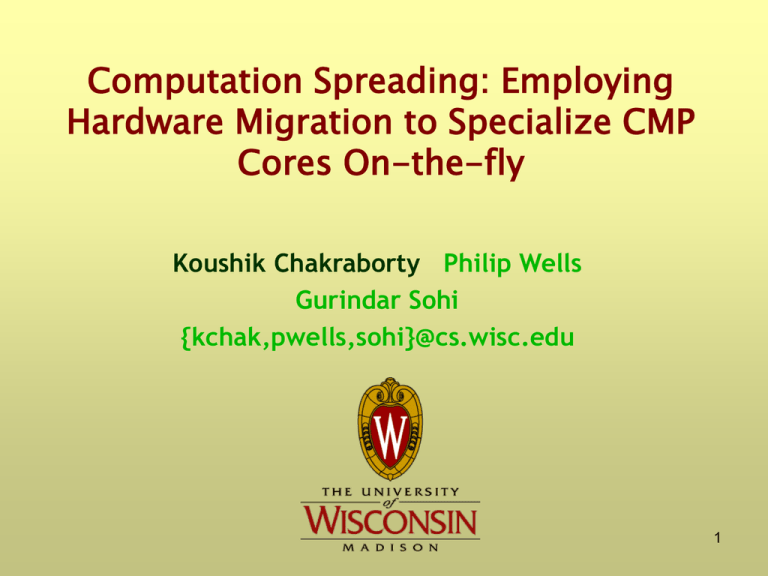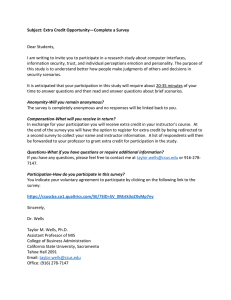Computation Spreading: Employing Hardware Migration to Specialize CMP Cores On-the-fly Koushik Chakraborty
advertisement

Computation Spreading: Employing
Hardware Migration to Specialize CMP
Cores On-the-fly
Koushik Chakraborty Philip Wells
Gurindar Sohi
{kchak,pwells,sohi}@cs.wisc.edu
1
Paper Overview
Multiprocessor Code Reuse
Poor resource utilization
Computation Spreading
New model for assigning computation within
a program on CMP cores in H/W
Case Study: OS and User computation
Investigate performance characteristics
Chakraborty, Wells, and Sohi
ASPLOS 2006
2
Talk Outline
Motivation
Computation Spreading (CSP)
Case study: OS and User compution
Implementation
Results
Related Work and Summary
Chakraborty, Wells, and Sohi
ASPLOS 2006
3
Homogeneous CMP
Many existing systems are homogeneous
Sun Niagara, IBM Power 5, Intel Xeon MP
Multithreaded server application
Composed of server threads
Typically each thread handles a client request
OS assigns software threads to cores
• Entire computation from one thread execute on
a single core (barring migration)
Chakraborty, Wells, and Sohi
ASPLOS 2006
4
Code Reuse
Many client requests are similar
Similar service across multiple threads
Same code path traversed in multiple cores
Instruction footprint classification
Exclusive – single core access
Common – many cores access
Universal – all cores access
Chakraborty, Wells, and Sohi
ASPLOS 2006
5
Multiprocessor Code Reuse
Chakraborty, Wells, and Sohi
ASPLOS 2006
6
Implications
Lack of instruction stream specialization
Redundancy in predictive structures
• Poor capacity utilization
Destructive interference
No synergy among multiple cores
Lost opportunity for co-operation
Exploit core proximity in CMP
Chakraborty, Wells, and Sohi
ASPLOS 2006
7
Talk Outline
Motivation
Computation Spreading (CSP)
Case study: OS and User compution
Implementation
Results
Related Work and Summary
Chakraborty, Wells, and Sohi
ASPLOS 2006
8
Computation Spreading (CSP)
Computation fragment = dynamic instruction
stream portion
Collocate similar computation fragments from
multiple threads
Enhance constructive interference
Distribute dissimilar computation fragments
from a single thread
Reduce destructive interference
Reassignment is the key
Chakraborty, Wells, and Sohi
ASPLOS 2006
9
Example
time
T1 T2 T3
A1 B2 C3
B1 C2 A3
C1 A2 B3
C
A
N
O
N
I
C
A
L
A1 B2 C3
B1 C2 A3
C1 A2 B3
P1 P2 P3
A1 B2 C3
C
S
P
A3 B1 C2
A2 B3 C1
Chakraborty, Wells, and Sohi
ASPLOS 2006
10
Key Aspects
Dynamic Specialization
Homogeneous multicore acquires specialization via
retaining mutually exclusive predictive state
Data Locality
Data dependencies between different computation
fragments
Careful fragment selection to avoid loss of data
locality
Chakraborty, Wells, and Sohi
ASPLOS 2006
11
Selecting Fragments
Server workloads characteristics
Large data and instruction footprint
Significant OS computation
User Computation and OS Computation
A natural separation
Exclusive instruction footprints
Relatively independent data footprint
Chakraborty, Wells, and Sohi
ASPLOS 2006
12
Data Communication
Core 1
Core 2
T1-User
T2-User
T1
T2
T1-OS
T2-OS
Chakraborty, Wells, and Sohi
ASPLOS 2006
13
Relative Inter-core Data
Communication
Apache
OLTP
OS-User Communication is limited
Chakraborty, Wells, and Sohi
ASPLOS 2006
14
Talk Outline
Motivation
Computation Spreading (CSP)
Case study: OS and User compution
Implementation
Results
Related Work and Summary
Chakraborty, Wells, and Sohi
ASPLOS 2006
15
Implementation
Migrating Computation
Transfer state through the memory subsystem
• ~2KB of register state in SPARC V9
• Memory state through coherence
Lightweight Virtual Machine Monitor
Migrates computation as dictated by the CSP Policy
Implemented in hardware/firmware
Chakraborty, Wells, and Sohi
ASPLOS 2006
16
Threads
Implementation cont
Software
Stack
Virtual CPUs
OS Comp
User Comp
Physical
Cores
User Cores
Chakraborty, Wells, and Sohi
Baseline
OS Cores
ASPLOS 2006
17
Threads
Implementation cont
Software
Stack
Virtual CPUs
Physical
Cores
User Cores
Chakraborty, Wells, and Sohi
OS Cores
ASPLOS 2006
18
CSP Policy
Policy dictates computation assignment
Thread Assignment Policy (TAP)
Maintains affinity between VCPUs and
physical cores
Syscall Assignment Policy (SAP)
OS computation assigned based on system
calls
TAP and SAP use identical assignment for
user computation
Chakraborty, Wells, and Sohi
ASPLOS 2006
19
Talk Outline
Motivation
Computation Spreading (CSP)
Case study: OS and User compution
Implementation
Results
Related Work and Summary
Chakraborty, Wells, and Sohi
ASPLOS 2006
20
Simulation Methodology
Virtutech SIMICS MAI running Solaris 9
CMP system: 8 out-of-order processors
2 wide, 8 stages, 128 entry ROB, 3GHz
3 level memory hierarchy
Private L1 and L2
Directory base MOSI
L3: Shared, Exclusive 8MB (16w) (75 cycle load-to-use)
Point to point ordered interconnect (25 cycle latency)
Main Memory 255 cycle load to use, 40GB/s
Measure impact on predictive structures
Chakraborty, Wells, and Sohi
ASPLOS 2006
21
L2 Instruction Reference
Chakraborty, Wells, and Sohi
ASPLOS 2006
22
Result Summary
Branch predictors
9-25% reduction in mis-predictions
L2 data references
0-19% reduction in load misses
Moderate increase in store misses
Interconnect messages
Moderate reduction (after accounting extra
messages for migration)
Chakraborty, Wells, and Sohi
ASPLOS 2006
23
Performance Potential
Migration Overhead
Chakraborty, Wells, and Sohi
ASPLOS 2006
24
Talk Outline
Motivation
Computation Spreading (CSP)
Case study: OS and User compution
Implementation
Results
Related Work and Summary
Chakraborty, Wells, and Sohi
ASPLOS 2006
25
Related Work
Software re-design: staged execution
Cohort Scheduling [Larus and Parkes 01], STEPS
[Ailamaki 04], SEDA [Welsh 01], LARD [Pai 98]
CSP: similar execution in hardware
OS and User Interference [several]
Structural separation to avoid interference
CSP avoids interference and exploits synergy
Chakraborty, Wells, and Sohi
ASPLOS 2006
26
Summary
Extensive code reuse in CMPs
45-66% instruction blocks universally accessed in
server workloads
Computation Spreading
Localize similar computation and separate
dissimilar computation
Exploits core proximity in CMPs
Case Study: OS and User computation
Demonstrate substantial performance potential
Chakraborty, Wells, and Sohi
ASPLOS 2006
27
Thank You!
Chakraborty, Wells, and Sohi
ASPLOS 2006
28
Backup Slides
Chakraborty, Wells, and Sohi
ASPLOS 2006
29
L2 Data Reference
L2 load miss comparable, slight to moderate increase
in L2 store miss
Chakraborty, Wells, and Sohi
ASPLOS 2006
30
Multiprocessor Code Reuse
Chakraborty, Wells, and Sohi
ASPLOS 2006
31
Performance Potential
Chakraborty, Wells, and Sohi
ASPLOS 2006
32





